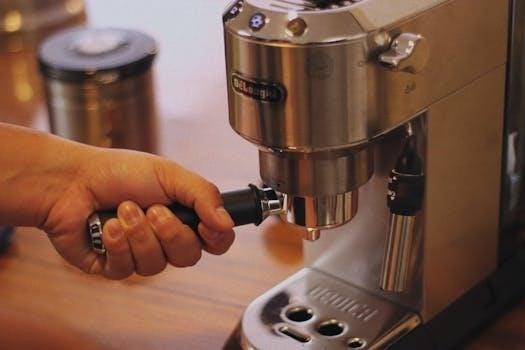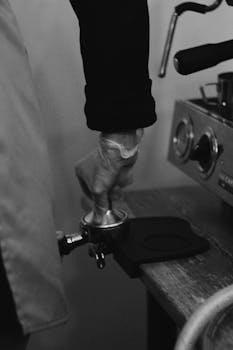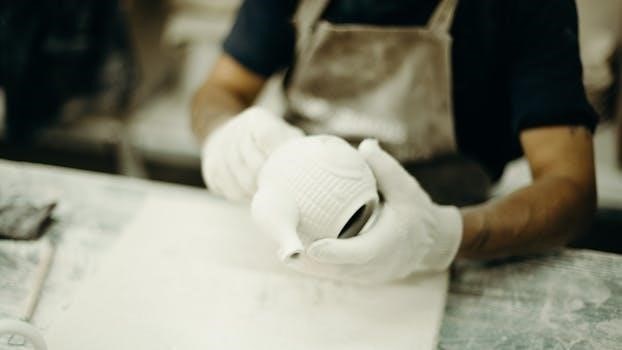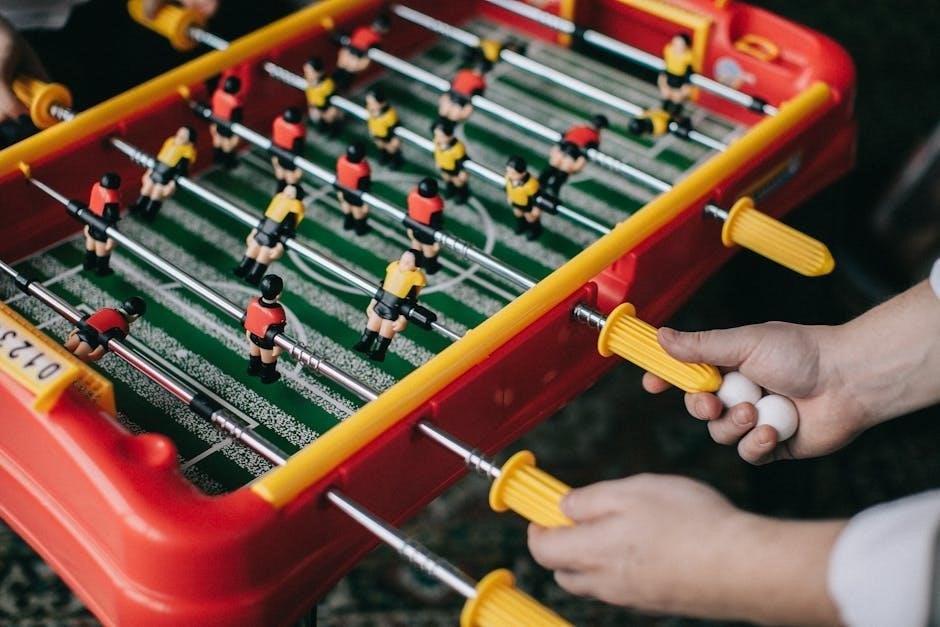
cuisinart espresso maker manual
Cuisinart Espresso Maker Manual⁚ Troubleshooting and Maintenance
Cuisinart espresso makers are known for quality. However, issues arise. This manual provides troubleshooting steps for common problems, like leaks or weak coffee. Maintenance tips, such as descaling, are included to extend the life of your machine.
Common Issues with Cuisinart Espresso Makers
Cuisinart espresso machines, while generally reliable, can encounter several common problems. These issues range from power-related malfunctions to brewing inconsistencies and water leakage. A frequent complaint is the espresso maker failing to turn on, often traced to a faulty switch, a tripped fuse, or simply not being plugged in correctly. Overheating can also occur, potentially due to a blown thermal fuse designed to prevent damage.
Brewing problems manifest as weak coffee, which can stem from an incorrect grind size or insufficient coffee grounds. Sometimes, the espresso maker stops mid-brew, potentially indicating a clog or a problem with the water pump. Leaks are another common concern, often originating from loose connections or a need for descaling.
Proper maintenance, including regular cleaning and descaling, is crucial to prevent these issues and prolong the lifespan of your Cuisinart espresso maker. Addressing these problems promptly ensures a consistently enjoyable espresso experience.

Power and Electrical Problems
Power and electrical issues with Cuisinart espresso makers can prevent operation. This section addresses common problems, like the machine not turning on. It also covers thermal fuse issues and potential overheating causes.
Espresso Maker Not Turning On
A Cuisinart espresso maker failing to power on can be frustrating. First, ensure the machine is correctly plugged into a functioning power outlet. Check the power cord for any damage. If plugged in correctly, examine the power switch for faults or loose connections. A tripped circuit breaker could also be the culprit; reset it if necessary; Some models have a reset button; consult your manual to locate it and attempt a reset.
If these steps don’t work, the issue may be internal, such as a blown fuse or a faulty heating element. Remember safety first. Before investigating further, disconnect the espresso maker from the power source. If you’re uncomfortable with electrical repairs, consider contacting a qualified appliance technician or Cuisinart customer support for assistance.
Thermal Fuse Issues and Overheating
Overheating in a Cuisinart espresso maker can trigger the thermal fuse, a safety mechanism that cuts off power to prevent damage. If your machine isn’t heating or has completely shut down, a blown thermal fuse is a likely cause. Before replacing it, determine why it blew. Mineral buildup, a faulty thermostat, or a malfunctioning heating element can all contribute to overheating.
Descaling the machine regularly can prevent mineral buildup. Inspect the thermostat for proper function; if faulty, it needs replacement. If the heating element is drawing excessive current, it also needs to be replaced. Replacing the thermal fuse without addressing the underlying cause will only lead to repeated failures. Remember to disconnect the espresso maker from the power source before any repairs.
Brewing Problems
Brewing issues with your Cuisinart espresso maker? Common problems include weak coffee or the machine stopping mid-brew. These stem from grind size, water levels, or clogs. Troubleshooting steps can restore optimal brewing performance.
Weak Coffee Issues
Experiencing weak coffee from your Cuisinart espresso maker? Several factors contribute to this. First, check the grind size; it may be too coarse for espresso. A finer grind ensures proper extraction. Insufficient coffee grounds also lead to weak coffee. Ensure you’re using the correct amount, typically a tightly packed scoop per shot. Water temperature plays a role; verify that the machine is heating to the appropriate temperature for optimal extraction.
Mineral buildup can affect performance, so descaling regularly is crucial. A clogged filter can also hinder extraction, so clean it thoroughly. Finally, consider the quality of your beans. Stale or low-quality beans will invariably result in weak, unsatisfying espresso. Addressing these points should improve your coffee’s strength.
Coffee Maker Stops Mid-Brew
If your Cuisinart espresso maker halts mid-brew, several potential culprits exist. Overheating is a common reason; the thermal fuse may have tripped to prevent damage. Allow the machine to cool completely before attempting to restart it. Mineral buildup can restrict water flow, causing the machine to stop. Descaling regularly helps prevent this issue.
Another possibility is a faulty pump; it may be struggling to maintain consistent water pressure. Check for any obstructions in the water reservoir or inlet. Insufficient water in the reservoir will also cause the brewing process to cease. Ensure the water level is adequate before starting. If problems persist, the heating element may be failing, requiring professional repair.

Water and Leaking Problems
Water-related issues are common. Leaks can occur from various points. Pumping problems may prevent water from flowing. Addressing these promptly is crucial for maintaining espresso maker function and preventing further damage.
Espresso Maker Leaking Water
If your Cuisinart espresso maker is leaking water, several factors could be at play. Start by checking the water reservoir for cracks or improper seating. Ensure it’s correctly positioned and securely attached to the machine. Inspect the seals and gaskets around the reservoir and brewing components for wear or damage, replacing them if necessary. Overfilling the water reservoir can also cause leaks, so adhere to the recommended fill lines.
Examine the connections between the water tank, pump, and boiler for loose fittings. Tighten any connections carefully to prevent leaks. A clogged or partially blocked water line can create pressure, leading to leaks. Descale your espresso maker regularly to prevent mineral buildup, which can damage seals and cause leaks. If the leaking persists, consult a qualified appliance repair technician for further assistance.
Water Not Pumping
A Cuisinart espresso maker that fails to pump water often indicates a blockage or pump malfunction. Begin by ensuring the water reservoir is adequately filled and properly seated. Check the water intake filter for clogs; clean it thoroughly. Air pockets in the system can impede water flow, so prime the pump by running a brewing cycle without coffee grounds.
Descale the machine, as mineral deposits can obstruct water lines and the pump. Inspect the pump itself for any signs of damage or wear. If the pump is not functioning, it may require replacement. A faulty check valve can also prevent proper water flow, so inspect and replace if needed. If issues persist, seek guidance from a qualified repair technician.

Cleaning and Maintenance
Regular cleaning and maintenance are vital for Cuisinart espresso makers. Descaling removes mineral buildup, ensuring optimal performance. Cleaning the grinder prevents clogs and maintains grind consistency, contributing to better-tasting espresso and prolonging machine life.
Descaling with Vinegar
Descaling your Cuisinart espresso maker with vinegar is a simple way to remove mineral buildup that can affect performance and taste. Minerals from tap water can clog the machine over time, impacting heating and brewing efficiency. A vinegar solution effectively dissolves these deposits, restoring your espresso maker to its optimal condition.
To descale, mix equal parts white vinegar and water. Fill the water reservoir with the solution and run a brewing cycle. Allow the solution to sit in the machine for about 30 minutes to loosen mineral deposits. Then, complete the brewing cycle, followed by rinsing the machine with fresh water. Repeat the rinsing process until the vinegar smell disappears. Regular descaling, every 1-3 months depending on water hardness, ensures your Cuisinart delivers delicious espresso for years to come.
Cleaning the Burr Mill Coffee Grinder
Maintaining a clean burr mill coffee grinder is essential for optimal performance and flavor. Coffee grounds and oils accumulate, affecting grinding consistency and taste. Regular cleaning prevents clogs and ensures a fresh, flavorful cup of coffee. Start by unplugging the grinder.
Remove the bean hopper and grind chamber. Use a soft brush to clear away loose grounds from the burrs and interior. For stubborn residue, a damp cloth can be used, ensuring all parts are completely dry before reassembling. Avoid using water directly on the burrs. Periodically, deep cleaning may be necessary. Consider using grinder cleaning tablets to remove oils and residue effectively. Proper cleaning guarantees consistent grinding and extends the lifespan of your Cuisinart burr mill.

Specific Model Troubleshooting (EM-200C, EM-100C)
This section addresses issues specific to the Cuisinart EM-200C and EM-100C espresso maker models. Find targeted solutions for common problems, repair tips, and model-specific maintenance advice to keep your machine running smoothly.
Troubleshooting the EM-200C Model
The Cuisinart EM-200C espresso maker, a popular model, may encounter specific issues; If your EM-200C isn’t powering on, first ensure it’s properly plugged in and the outlet works. Mineral buildup can cause power issues, so try descaling with vinegar. If the espresso isn’t hot enough, the heating element might be faulty or the thermal fuse blown, requiring professional repair.
Water leaks are another common problem; check the seals and connections, ensuring they’re tight and undamaged. If the machine isn’t dispensing coffee, it could be a pump failure or a blockage; try cleaning the system thoroughly.
If you are still facing issues, consider resetting the machine. These steps can help resolve many EM-200C issues, ensuring your machine continues to brew delicious espresso.
Repairing the EM-100C Espresso Maker
The Cuisinart EM-100C espresso maker, while reliable, can sometimes experience problems. A common issue is the water pump failing, preventing the machine from brewing. Before seeking professional help, check for simple fixes. Ensure the water reservoir is properly filled and seated correctly. Mineral deposits can clog the pump, so descaling with a vinegar solution might restore functionality.
If the machine isn’t heating, a blown thermal fuse could be the culprit. Replacing this fuse, though requiring some technical skill, can often resolve the problem. For leaking issues, inspect the seals and connections, tightening or replacing them as needed.
If the frothing function malfunctions, clean the frothing wand thoroughly to remove milk residue. These troubleshooting steps can often extend the life of your EM-100C.


Leave a Reply
You must be logged in to post a comment.